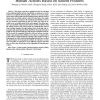Free Online Productivity Tools
i2Speak
i2Symbol
i2OCR
iTex2Img
iWeb2Print
iWeb2Shot
i2Type
iPdf2Split
iPdf2Merge
i2Bopomofo
i2Arabic
i2Style
i2Image
i2PDF
iLatex2Rtf
Sci2ools
TCSV
2008
2008
Expandable Data-Driven Graphical Modeling of Human Actions Based on Salient Postures
This paper presents a graphical model for learning and recognizing human actions. Specifically, we propose to encode actions in a weighted directed graph, referred to as action graph, where nodes of the graph represent salient postures that are used to characterize the actions and are shared by all actions. The weight between two nodes measures the transitional probability between the two postures represented by the two nodes. An action is encoded as one or multiple paths in the action graph. The salient postures are modeled using Gaussian mixture models (GMMs). Both the salient postures and action graph are automatically learned from training samples through unsupervised clustering and expectation and maximization (EM) algorithm. The proposed action graph not only performs effective and robust recognition of actions, but it can also be expanded efficiently with new actions. An algorithm is also proposed for adding a new action to a trained action graph without compromising the existin...
| Added | 15 Dec 2010 |
| Updated | 15 Dec 2010 |
| Type | Journal |
| Year | 2008 |
| Where | TCSV |
| Authors | Wanqing Li, Zhengyou Zhang, Zicheng Liu |
Comments (0)

